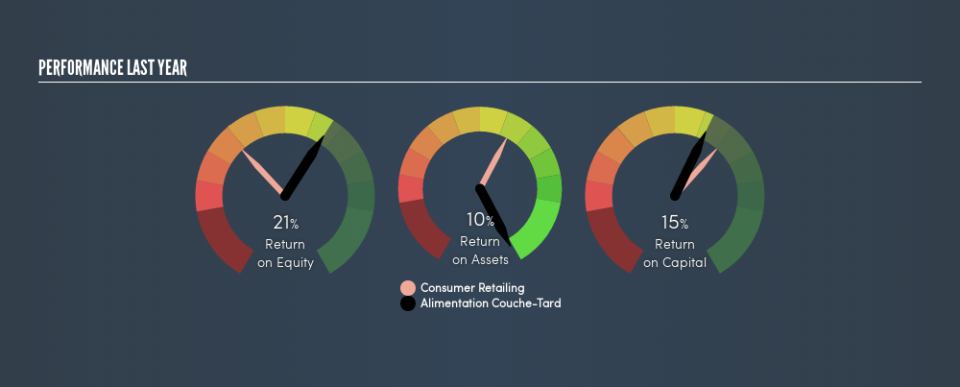A Close Look At Alimentation Couche-Tard Inc.’s (TSE:ATD.B) 15% ROCE

Want to participate in a research study? Help shape the future of investing tools and earn a $60 gift card!
Today we'll look at Alimentation Couche-Tard Inc. (TSE:ATD.B) and reflect on its potential as an investment. In particular, we'll consider its Return On Capital Employed (ROCE), as that can give us insight into how profitably the company is able to employ capital in its business.
First of all, we'll work out how to calculate ROCE. Next, we'll compare it to others in its industry. And finally, we'll look at how its current liabilities are impacting its ROCE.
What is Return On Capital Employed (ROCE)?
ROCE measures the amount of pre-tax profits a company can generate from the capital employed in its business. In general, businesses with a higher ROCE are usually better quality. In brief, it is a useful tool, but it is not without drawbacks. Renowned investment researcher Michael Mauboussin has suggested that a high ROCE can indicate that 'one dollar invested in the company generates value of more than one dollar'.
How Do You Calculate Return On Capital Employed?
The formula for calculating the return on capital employed is:
Return on Capital Employed = Earnings Before Interest and Tax (EBIT) ÷ (Total Assets - Current Liabilities)
Or for Alimentation Couche-Tard:
0.15 = US$2.6b ÷ (US$22b - US$4.9b) (Based on the trailing twelve months to February 2019.)
So, Alimentation Couche-Tard has an ROCE of 15%.
View our latest analysis for Alimentation Couche-Tard
Does Alimentation Couche-Tard Have A Good ROCE?
When making comparisons between similar businesses, investors may find ROCE useful. Alimentation Couche-Tard's ROCE appears to be substantially greater than the 9.6% average in the Consumer Retailing industry. I think that's good to see, since it implies the company is better than other companies at making the most of its capital. Regardless of where Alimentation Couche-Tard sits next to its industry, its ROCE in absolute terms appears satisfactory, and this company could be worth a closer look.
Remember that this metric is backwards looking - it shows what has happened in the past, and does not accurately predict the future. ROCE can be deceptive for cyclical businesses, as returns can look incredible in boom times, and terribly low in downturns. ROCE is only a point-in-time measure. Future performance is what matters, and you can see analyst predictions in our free report on analyst forecasts for the company.
Alimentation Couche-Tard's Current Liabilities And Their Impact On Its ROCE
Current liabilities are short term bills and invoices that need to be paid in 12 months or less. The ROCE equation subtracts current liabilities from capital employed, so a company with a lot of current liabilities appears to have less capital employed, and a higher ROCE than otherwise. To counter this, investors can check if a company has high current liabilities relative to total assets.
Alimentation Couche-Tard has total assets of US$22b and current liabilities of US$4.9b. Therefore its current liabilities are equivalent to approximately 22% of its total assets. Current liabilities are minimal, limiting the impact on ROCE.
What We Can Learn From Alimentation Couche-Tard's ROCE
Overall, Alimentation Couche-Tard has a decent ROCE and could be worthy of further research. Of course, you might find a fantastic investment by looking at a few good candidates. So take a peek at this free list of companies with modest (or no) debt, trading on a P/E below 20.
I will like Alimentation Couche-Tard better if I see some big insider buys. While we wait, check out this free list of growing companies with considerable, recent, insider buying.
We aim to bring you long-term focused research analysis driven by fundamental data. Note that our analysis may not factor in the latest price-sensitive company announcements or qualitative material.
If you spot an error that warrants correction, please contact the editor at editorial-team@simplywallst.com. This article by Simply Wall St is general in nature. It does not constitute a recommendation to buy or sell any stock, and does not take account of your objectives, or your financial situation. Simply Wall St has no position in the stocks mentioned. Thank you for reading.

 Yahoo Finance
Yahoo Finance 
